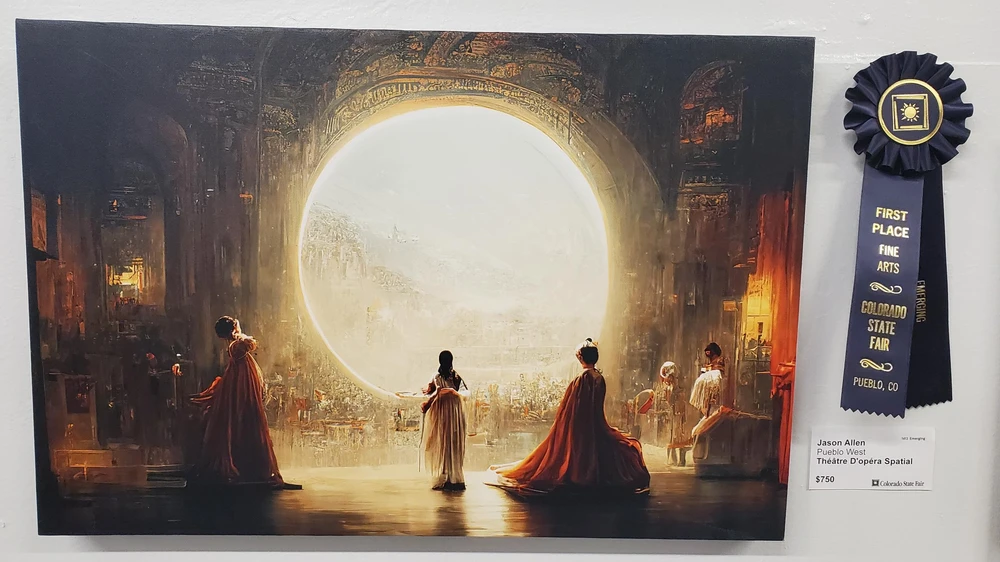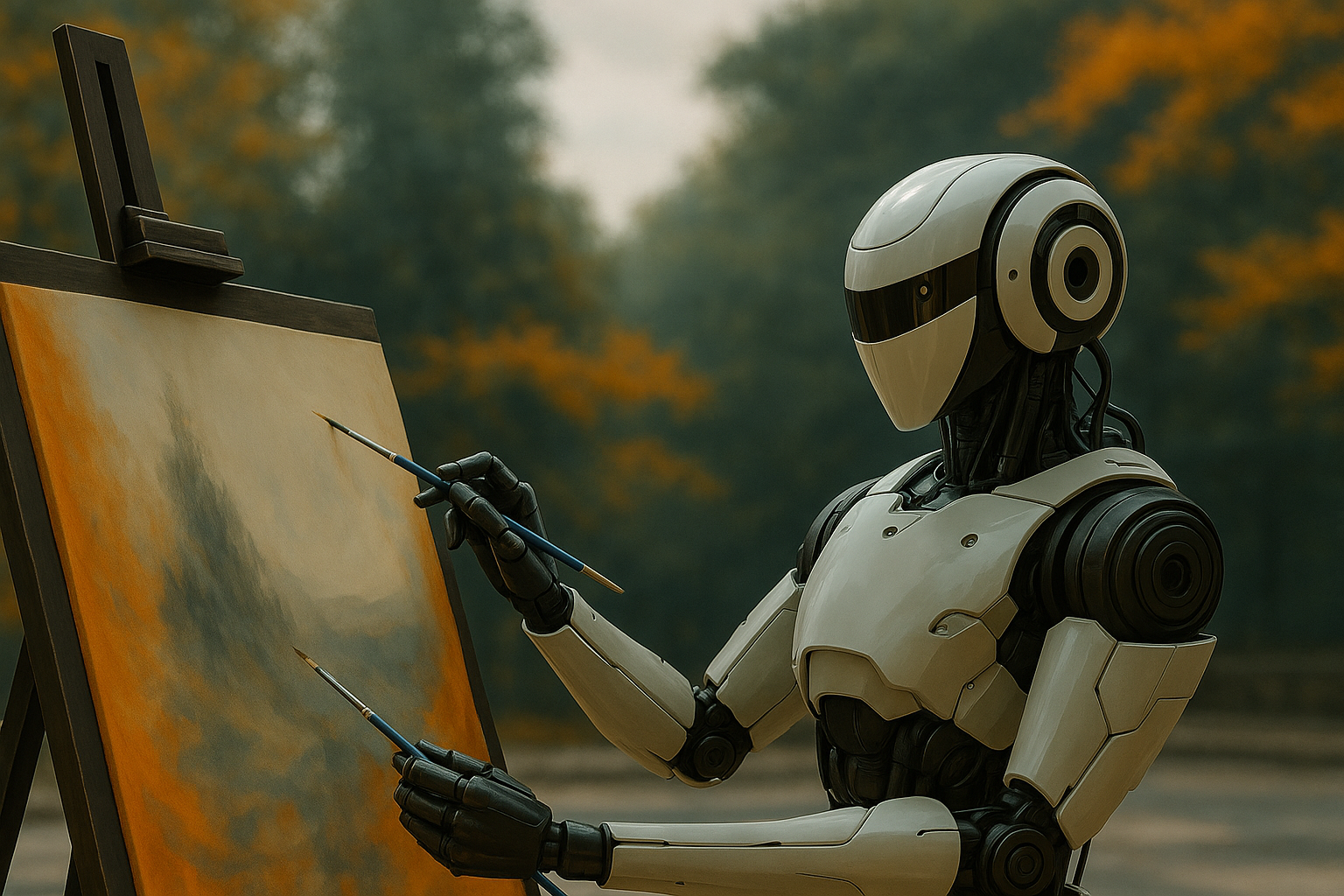Art is the lie that enables us to realize the truth. – Pablo Picasso
AI & Art
The Awkward Dance Between Genius and Algorithm
AI is no longer the distant hum of the future; it’s here, sketching portraits, writing symphonies, and even winning art competitions. Depending on who you ask, it’s either the end of artistry as we know it, or just the newest brush in the paintbox. Truth? It’s both thrilling and terrifying. The question is: will artists be replaced, or just redefined?
AI in Art
Promise & Panic
Algorithms now compose music, paint landscapes, and write poetry in seconds. To some, that’s liberation new tools, fresh canvases, faster workflows. To others, it’s an existential nightmare: soulless images flooding galleries, authenticity stripped away, art reduced to prompts.
The fear isn’t new. Every technology that touched art from the printing press to Photoshop has sparked the same panic. But as Philip Pullman once said, “Children are not passive recipients… they bring their own imagination.” Swap “children” with “artists,” and the point holds: creativity isn’t in the tool, it’s in the human wielding it.
History of Tech Panic
Every new tool sparks old fears
The 19th-century camera was accused of “killing painting.” Spoiler: painting survived. The rise of digital art triggered outrage from traditionalists. Spoiler again: oil painters still have jobs.
AI is today’s Camera Obscura mistrusted at first, normalized later. As Heidegger warned, “The essence of technology is by no means anything technological.” In other words, the fear isn’t the tool itself, it’s our story about it.
AI as Collaborator, Not Competitor
Think intern, not imposter
Ann Ploin at Oxford Internet Institute frames AI well: it won’t replace artists, it will complement them. Machines churn out drafts at scale, but the decision-making the soul of creativity still belongs to humans.
Think of AI as an unpaid intern: quick with the grunt work, terrible at judgment. It’ll help brainstorm, refine, remix but it won’t know why one shade of red makes you cry while another feels cheap. That’s human territory, and it’s not going away.
Cheating or Just Competing?
The problem isn’t AI, it’s labels
Jason Allen (aka “Sincarnate”) won a fine art prize at the 2022 Colorado State Fair with an AI-generated canvas. Cue outrage. Was it cheating? Maybe but only if you call photography “cheating” at a painting contest. The real ethical breach wasn’t the use of AI, but the lack of disclosure.

SCREENGRAB: DISCORD.
This is where the art world is still fumbling: categories haven’t caught up. It’s less “AI is stealing” and more “we don’t have the right labels yet.”
Copyright in the Age of Copy-Paste
Lawyers are the only winners (for now)
AI brings a migraine to copyright law. Who owns an AI image the coder, the prompter, or the dataset’s original artists? Lawsuits like Getty vs. Stability AI suggest the battle is just warming up.
Countries are improvising: the UK now has a category for computer-generated works without human authorship. But the big issue is derivative data. AI models are trained on millions of copyrighted works. If your dataset is built on Monet, how much of Monet bleeds into your machine-made “original”?
The courts will take years to settle this. Meanwhile, artists are left in limbo.
Do People Even Care?
Pretty, cheap, fast most don’t
Here’s the uncomfortable truth: many buyers don’t care how art is made. They want it fast, pretty, and affordable. Auction houses dabble in AI pieces, while collectors still prize scarcity and the human signature.
It mirrors books vs. e-books: digital dominates for convenience, but first editions still sell for thousands. AI art will likely follow that split mass adoption on one side, niche prestige on the other.
A Playbook for Artists
Practical beats panic every time
So, what’s a working artist supposed to do? Panic helps no one. Practicality does.
- Use AI as a draft machine. Let it handle early sketches, mood boards, or variations. Save your energy for the parts that matter.
- Be transparent. If you used AI, say so. Audiences value honesty more than mystique.
- Claim your niche. AI can imitate, but it can’t invent you. Lean harder into personal style, story, and imperfection.
- Diversify. Don’t rely on commissions alone; explore teaching, curation, or community-building around your art.
- Stay legal-aware. Follow copyright cases. Know your rights before someone “samples” your style.
- Collaborate with tech. Partner with AI, don’t fight it. If you can’t outpace the machine, out-human it.
Design & Innovation Digest
Smart picks to dive deeper
- Creative Bloq — Best Graphic Design Software 2024: “A map of the tools defining digital creativity.”
- TechCrunch — Canva’s Magic Studio Explained: “Where AI meets design for the masses.”
- TechRadar — CorelDRAW Suite 2024 Review: “Old-school software learns new AI tricks.”
- Wired — AI’s Creative Surge: “How machines are reshaping imagination.”
- 99Designs — Design Trends 2024: Bold, Simple & 3D:” The look of tomorrow’s art”.
Final Thought
AI is a mirror, not a muse.
Picasso once said art is the lie that tells the truth. Maybe AI is just another kind of lie one more filter, one more illusion. But the truth of art remains stubbornly human: we crave meaning, not just beauty.
So no, AI isn’t replacing artists. It’s just forcing them to answer the oldest question in new ways: what makes your work worth caring about?
References
- Delgado, Francisco et al. (2023):The Participatory Turn in AI Design
- Gu, Lingyu et al. (2022): Who Made the Paintings: Artists or Artificial Intelligence?
- McCormack, Jon et al. (2021):Autonomy, Authenticity, Authorship and Intention in Computer Generated Art
- Mikalonytė, Lina & Kneer, Markus (2020):Can Artificial Intelligence Make Art?
- Ploin, Anne et al. (2022): AI and the Arts: How Machine Learning is Changing Artistic Work




